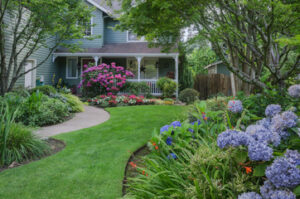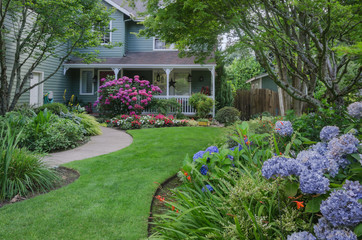A well-designed landscape can have a significant impact on your home. It can provide a quiet retreat, serve as an extension of your living space and offer a beautiful focal point.

Flowering trees make a bold statement in your yard and help to herald the arrival of warm weather for those living in northern climates. Choosing plants that will thrive in your garden’s conditions helps you save on maintenance and water costs. Contact Greensboro Landscaping for professional help.
While matching your landscape design to the architectural style of your home is an important consideration, it’s also essential that you take into account your personal aesthetic. Your outdoor landscape can express many of the same qualities as your clothes and home furnishings—whether that’s warmth, fluidity, or a crisp, clean look. To help you pinpoint your landscaping style, consider the following landscape designs.
Informal
A popular choice for residential gardens, informal landscape designs give a natural and organic feel to your space with curves, different textures and a mix of several types of flowers and plants. Curved pathways and meandering flower beds are complemented by weathered wood features, stone masonry, or even old brick pavers. Creating a sense of spontaneity, informal designs allow for wildflowers and grasses to take center stage and create a sense of natural beauty and unpredictability.
Rustic
Rustic and country-style landscape designs are tidy and celebrate the simplistic beauty of natural elements. These styles make extensive use of stone masonry, large timbers and wrought iron. Dead limbs or snags are left to decompose rather than removed, and native or adapted plants that benefit wildlife are incorporated into the hardscape and softscaping.
Transitional
As the name implies, transitional landscapes incorporate elements from both traditional and modern styles to create a dichotomous meeting of nature and artifice. Hedgerows and thoroughly organized bands of flora are complemented by simplified and angular walls, raised beds, and walkways.
Texture
Texture is a vital element to any garden, and it’s often overlooked. From the coarseness of a boulder to the fine details of a sculptural branch or flower, the contrast of texture adds depth and dimension to any landscape. Using a variety of textures throughout your garden is an easy way to add interest and intrigue.
Form
Shape is another element of a landscape to be considered, whether it’s the shape of a plant or the geometry of a pathway or water feature. Using the shape of your landscape as an expression of your personal style is a great way to distinguish your yard from others.
Natural California or Mediterranean Style Gardens
The stunning beauty of natural California or Mediterranean style gardens offers a unique approach to landscape design, blending the art of gardening with nature’s beauty. Designed to showcase the lush greenery of plants indigenous to the area’s climate, these landscapes feature dramatic textures and colors alongside stone and water elements that provide additional visual interest.
The California and Mediterranean style of garden features drought-tolerant plants, creating beautiful and sustainable outdoor spaces for relaxing, dining, and entertaining. These gardens also promote environmental awareness through the use of native and low-water plantings. Many of the native flora found in this style are native to Southern California or other regions with similar weather, so they tend to require less water than non-native varieties.
These gardens offer a variety of textures, colors, and flowers that attract hummingbirds, butterflies, and bees. A mix of low-growing succulents, such as aloe and agave, and flowering shrubs like bougainvillea and roses are ideal for this garden style. Adding low-growing ground cover such as sempervivum and sedum, along with a variety of low-growing, fragrant grasses like rosemary and lavender, is also a key element to achieving this look.
Planting trees in the California or Mediterranean style is another way to bring a sense of the Mediterranean to your home. Slow-growing, erect deciduous trees such as the red-brown shredding bark of manzanita (Arctostaphylos bakeri) and urn-shaped pale pink blooms of phlox ‘Betty Hill’ add form and color to the landscape. Low-growing perennials like rock purslane (Portulaca oleracea) and razzleberri (Ribes aureus) add color to the ground and can be used as a filler in borders, rock gardens and containers.
A trellis or pergola ideas is an easy addition to a Mediterranean style garden, bringing the feeling of a French Riviera or Greek village to your yard. The colorful blooms of bougainvillea scrambling up a trellis idea or the greenery and grape vines winding around a pergola create a sense of place and help to tie the different parts of your landscape together.
This garden style uses a variety of hardscape elements to encourage interaction with the plants, including paths and benches. Using exposed-aggregate concrete paving, decorative tiles, and earthy tones for accents helps to create an organic feel. The use of terra cotta pots and jars is common for this style, providing a rustic accent to the earthy tones of the garden and acting as an attractive focal point.
English Garden
The English garden combines color, structured plantings, formal hedges and topiary, water features, stone walls and seating areas to create a timeless style. Its foundation is laid by perennial and annual flowers like lady’s mangle, foxgloves, peonies, delphiniums, phlox and hollyhocks mixed with herbs, shrubs, grasses, and evergreens. Its best feature is its ability to look beautiful year-round. English gardens are also designed to attract pollinators and wildlife to the garden, so it is important to plant a variety of plants that flower at different times throughout the year.
In the mid-18th century, the landscape garden replaced the Baroque and Rococo styles as the dominant style of landscaping in England. Lancelot “Capability” Brown was a major influence on this new garden style, turning the rolling green hills and wide vistas of the English countryside into Elysian fields at palaces and estates such as Blenheim, Stowe, and Claremont. He was able to do this by creating serpentine lakes and walks, and rearranging the topography of hills, woods, and meadows to form pleasing views.
This style of landscaping is influenced by the Romantic movement that promoted feelings, subjectivity, emotion, and spontaneity in garden design. It was also influenced by the gardens of Gertrude Jekyll, who believed that the garden should be an extension of the home and not just a place for ornamental plants.
Another key characteristic of the English garden is its asymmetry. This gives the garden a sense of discovery and surprise as it unfolds during a walk through the garden. Paths are not always straight, and asymmetrical elements such as temples, bridges, Gothic chapels, obelisks, and ruins are often used to add visual interest.
In many English gardens, there is a strong emphasis on the use of natural materials such as rocks, gravel and wood. It is also common to see a mix of native plants and exotic horticultural species that are adapted to the region.
A final characteristic of the English garden is the addition of decorative art. Statues, urns, and fountains can be used to create focal points or to highlight special features of the garden. They can be traditional like cherubs and angels or more modern in style such as a reflective gazing ball.
Traditional Garden
When you think of traditional gardens, the first thing to come to mind is a pristine landscape where geometric shapes and symmetry are prominent. You’ll also likely see large areas of green grass surrounded by gravel paths. These gardens are often used to display the wealth and status of the owner with features like fountains, statues and more.
A traditional garden is not for the faint of heart and does require a higher level of maintenance than some other styles. It’s important to research the plants that will thrive in your climate before starting this type of garden. For example, many plants that grow well in traditional gardens require plenty of sunlight to reach their full potentials. Then, select plants that will complement your house’s architecture, such as a rose or wisteria for an English garden or hydrangea or hollyhocks for a traditional American garden.
The traditional garden style was popularized by the kings and queens of 17th century Europe who wanted to showcase their power, beauty and elegance in their outdoor spaces. They designed symmetrical gardens with a lot of ornamentation including statues, water features and even a garden maze.
Today, you can easily recreate the classic garden look in your own backyard without requiring a massive amount of time and money to maintain it. Many of the classic flowers and shrubs still require lots of sun to thrive, such as rambling roses, lavender, peonies, wisteria and hollyhocks. But, you can cut back on the amount of time and effort required to keep them looking pristine by using low-maintenance bushes with a tidy, uniform appearance.
Hardscaping is also key when creating a traditional garden. When selecting pavers and other surfaces for your garden, steer clear of textures that lean toward a rustic or weathered look that would fit more into a cottage or natural style garden. Look for materials such as slate, stone and composite decking that are solid colors to keep your garden feeling polished and clean.
Add a touch of formality to your garden by adding columns in a symmetrical design. These can be made of wrought iron or even solid white to emphasize the classical feel of your garden. If you want to spruce up your garden and take it up a notch, consider using a traditional style fountain to bring movement to your space.

